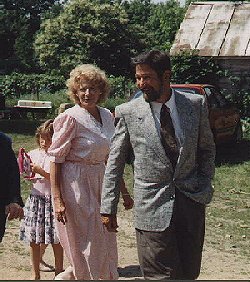 enough
contacts to know that the homesteading movement is alive and well.
enough
contacts to know that the homesteading movement is alive and well.
The sign along the road in front of our farmhouse
says "School of Homesteading." It has been there for 25 years, inviting
interested people to stop by and share their experiences of, or hopes for,
a more self-reliant way of life. Since we are listed in the Internet
and by the USDA and ATTRA (Appropriate Technology Transfer to Rural Areas)
as a place to learn about sustainable food production, we also hear from
many young people from all over the country who are seeking apprenticeships
on self-provisioning organic farms. Although these wanna-be homesteaders
are only a tiny minority in our society, we have  enough
contacts to know that the homesteading movement is alive and well.
enough
contacts to know that the homesteading movement is alive and well.
What kind of people are the homesteaders of today? Although many farm families produce their own food, modern homesteaders are people who move back to the land, away from a stressful urban lifestyle in search of an alternative to a life of "getting and spending." They are people in search of healthy food and the so-called "simple life"--simple at least in its lower demand for consumer goods, but not simple in the complex and varied skills it requires. Many of the older homesteaders were part of the big back-to-the-land movement of the 1970s which grew out of the counterculture of the 1960s. Some of these have become serious organic farmers; others settled for part-tiome jobs or for some means of self-employment to meet the need for cash. Most continue to allocate time for farming or gardening activities as well.
Now, in the 1990s, a new wave of homesteaders has emerged--with much less media attention. These new homesteaders seem to be more sensible and ordinary people, less revolutionary than their predecessors in the 1970s, and more willing compromise with technology. The ones we have met can be classified into four types, and like all types they blend into each other.
First, to start with one extreme, there are vegetarians trying to move beyond their concern with diet (macrobiotic or ayurvedic, for example) to a deeper relationship with the earth. They often try to do this in the context of some exotic religion.
Second, and perhaps the majority of new homesteaders, are those motivated by ecological concerns to search for an energy-conserving and sustainable way of life. Their desire is for the simple life. On a personal level it may be a search for authenticity, doing it yourself; on a political level it may be driven by disgust with a commodity-intensive lifestyle.
The third type, often Christian, wishes to be non-conformed to the world. Believing that the body is a living temple of the Holy Spirit, they are concerned about pure food. They are very family-oriented and usually home-school their children.
Fourth, to go to another extreme, there are politically-motivated homesteaders who want to get away from what they perceive to be the "New World Order." They may be sympathetic to the concerns of the militia movement or members of a militia group. Since they expect revolution and chaos, they are actively promoting self-reliance on household and community levels as a means of survival in the future.
To summarize, we can say there is a significant new wave of people who see living on the land, and "off" the land, as a sensible solution to the problems of the global, industrialized economy. They prefer a self-reliance that works with natural energy flows and, where possible, in harmony with nature.
Maynard and Barbara are "online" at maybar@i2k.com